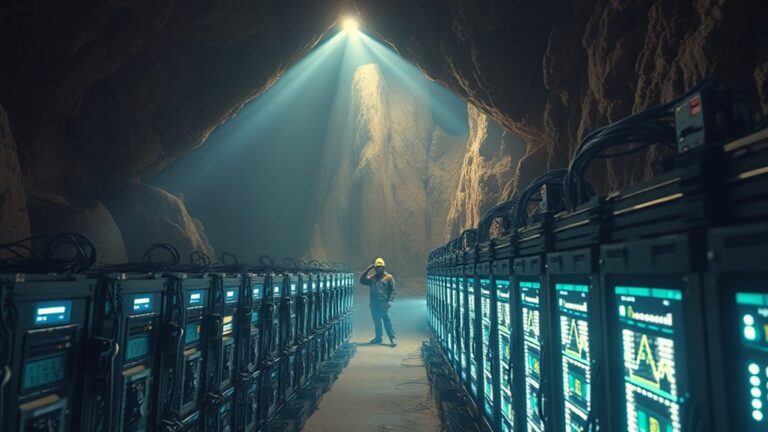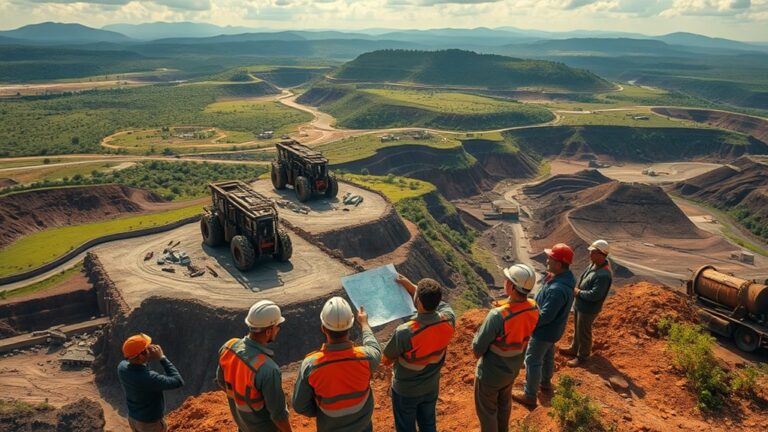
Crypto Mining: How Does It Work?
Crypto mining is the process of validating transactions on a blockchain network. Miners use powerful computers to solve complex mathematical puzzles, ensuring the authenticity of transactions. This process prevents double-spending, as miners confirm each transaction before adding it to the blockchain. Miners receive rewards in cryptocurrency for their efforts, along with transaction fees. The difficulty of these puzzles adjusts regularly to maintain network security. Further exploration will reveal more about the technology and challenges involved in crypto mining.
Key Takeaways
- Crypto mining involves validating transactions and maintaining the blockchain by solving complex mathematical problems using specialized hardware.
- Miners receive cryptocurrency rewards and transaction fees for confirming legitimate transactions and adding new blocks to the blockchain.
- The verification process utilizes consensus mechanisms like Proof-of-Work (PoW) or Proof-of-Stake (PoS) to ensure transaction integrity and network security.
- Mining requires significant energy, with PoW consuming more than PoS, prompting a shift towards sustainable practices and renewable energy sources.
- Successful miners compete to solve cryptographic puzzles, adjusting nonce values to meet the network’s mining difficulty, which changes based on overall hashrate.
What Is Crypto Mining?

Crypto mining serves as an essential mechanism in the world of digital currencies, facilitating the validation of transactions and the maintenance of the blockchain. This process involves solving complex mathematical problems using high-powered computers, which allows miners to verify transactions and add them to a decentralized digital ledger.
The term “mining” reflects the effort involved in extracting value, akin to searching for gold. Miners receive cryptocurrency as a reward for their successful verification efforts. However, mining requires specialized hardware, such as Application-Specific Integrated Circuits (ASICs), and consumes significant energy.
This decentralized participation enables anyone with internet access to contribute, ensuring a distributed mechanism without reliance on central authorities like banks, thereby enhancing transparency in financial transactions. Additionally, this process ensures the security and decentralization of the network by making it computationally expensive to alter the blockchain.
The Role of Miners in Transaction Validation

Miners play an essential role in the validation of transactions within cryptocurrency networks, ensuring that each transaction is legitimate and accurately recorded. They verify transactions using consensus mechanisms, such as Proof-of-Work (PoW), which requires solving complex mathematical problems.
This process helps prevent double-spending by confirming transactions before adding them to the blockchain. Once verified, miners create a new block containing these transactions and secure it within the blockchain, establishing a permanent record.
As compensation for their efforts, miners receive cryptocurrency rewards and transaction fees. This system incentivizes their participation and maintains the integrity of the network, allowing users to trust that their transactions are valid and properly recorded. Additionally, the Proof of Work mechanism ensures high security, making it challenging for malicious actors to alter the blockchain.
Understanding Blockchain Technology

Understanding blockchain technology is essential for grasping how modern digital transactions are conducted.
Blockchain is a decentralized digital ledger that records, stores, and verifies data securely across a peer-to-peer network. Its key features include decentralization, immutability, and consensus mechanisms that validate transactions.
Blockchain serves as a secure, decentralized digital ledger, ensuring data integrity through immutability and consensus-driven transaction validation.
Transactions are organized in blocks, linked through cryptographic hashes, creating a permanent chronological record. Different types of blockchains serve various purposes, such as public, private, or hybrid networks.
The decentralized nature guarantees transparency and shared responsibility among all participants, as each node maintains a copy of the blockchain. This setup enhances security by eliminating single points of failure, making blockchain technology a robust solution for various industries, including finance, healthcare, and supply chain management. Furthermore, its applications extend beyond cryptocurrency, such as enhancing supply chain management, showcasing its transformative potential across sectors.
How Transaction Verification Works

In the process of transaction verification, pending transactions are compiled from the network’s mempool, where they await validation.
Miners then engage in solving cryptographic puzzles, which involve complex mathematical calculations, to confirm the legitimacy of these transactions.
This combination of compiling and solving guarantees that only valid transactions are processed and added to the blockchain. Additionally, miners often invest in high-performance GPU selection to maximize their mining efficiency and profitability.
Pending Transactions Compilation
Pending transactions are a critical aspect of cryptocurrency networks, as they represent the unconfirmed transactions that have been broadcast to the system but have not yet been added to the blockchain.
These transactions are stored in a mempool, awaiting validation by miners. Factors like transaction fees and network congestion influence how quickly these transactions are confirmed.
When the network experiences high volumes of transactions, delays can occur, impacting the confirmation speed. Transaction finality is achieved only when a pending transaction is confirmed and included in a block.
While transactions remain pending, they are vulnerable to security risks, such as double-spending, making their timely confirmation essential for maintaining the integrity of the blockchain. Additionally, understanding transaction fees is crucial, as they can significantly impact the priority of pending transactions in the mempool.
Cryptographic Puzzle Solving
As miners participate in the cryptocurrency network, they engage in a crucial process known as cryptographic puzzle solving, which serves as the backbone for transaction verification.
This process utilizes the Proof of Work (PoW) mechanism, where miners search for a nonce that, when hashed with transaction data using the SHA-256 algorithm, produces a hash with a specific number of leading zeros.
The task involves significant trial and error, as miners must make millions of attempts to find a valid hash. This competition enhances network security and guarantees all transactions are confirmed.
Additionally, the difficulty of the puzzles adjusts periodically, maintaining an average block creation time of about 10 minutes, further solidifying the network’s integrity. Mining can be approached in different ways, such as through mining pools, which provide shared resources and more consistent rewards compared to solo mining.
The Process of Hashing and Solving Puzzles

Hashing serves as the backbone of the cryptocurrency mining process, playing an essential role in the verification and validation of blockchain transactions. This cryptographic procedure converts input data into a fixed-size string of characters, creating a unique digital fingerprint known as a hash.
In cryptocurrency mining, particularly Bitcoin, the SHA-256 algorithm is commonly utilized, often applied twice for added security. Miners group transactions into blocks and aim to solve complex mathematical puzzles by adjusting a nonce value, trying different combinations until a hash meets a specific target.
The difficulty of these puzzles guarantees blockchain security, as successful hash finding requires significant computational power and competition among miners, reinforcing the network’s integrity and stability. This dynamic relationship between mining difficulty and hash rate influences the overall mining ecosystem, prompting miners to continually enhance their technology for better efficiency.
The Concept of Proof of Work vs. Proof of Stake

The concepts of Proof of Work (PoW) and Proof of Stake (PoS) represent two distinct mechanisms for achieving consensus in cryptocurrency networks.
PoW relies on substantial energy consumption and computational power to secure transactions and maintain decentralization, while PoS offers a more energy-efficient approach by allowing validators to stake their coins for transaction validation. Understanding the differences in energy usage, security models, and implications for decentralization is essential for evaluating the effectiveness and sustainability of these systems in the evolving landscape of digital currencies. The transition from PoW to PoS, known as The Merge, has significantly altered the dynamics of Ethereum’s network and its impact on miners.
Energy Consumption Differences
Energy consumption varies considerably between the two primary consensus mechanisms used in cryptocurrency: Proof of Work (PoW) and Proof of Stake (PoS).
PoW requires substantial energy due to its competitive nature and complex puzzle-solving processes. In contrast, PoS is designed to be more energy-efficient, as it selects validators based on the number of tokens they hold.
Key differences include:
- Energy Use: PoW consumes markedly more energy than PoS.
- Environmental Impact: PoW contributes to higher carbon emissions.
- Operational Costs: PoS lowers operational costs for validators.
- Renewable Energy: PoW relies more on fossil fuels, while PoS encourages renewable sources.
- Efficiency: PoS can reduce energy needs by over 99% compared to PoW systems.
Furthermore, the shift towards renewable energy sources is becoming increasingly important for PoW miners to enhance sustainability and reduce operational costs.
Security and Decentralization
While both Proof of Work (PoW) and Proof of Stake (PoS) are designed to secure blockchain networks, they employ fundamentally different mechanisms to achieve this goal. PoW relies on solving complex cryptographic puzzles, making attacks costly due to high computational requirements. Conversely, PoS uses staked cryptocurrency as collateral, focusing on economic incentives for security. Both models aim for decentralization but differ in scalability and consensus methods. Additionally, the rise of decentralized finance has further highlighted the importance of these consensus mechanisms in maintaining secure and efficient blockchain networks.
| Feature | Proof of Work (PoW) | Proof of Stake (PoS) |
|---|---|---|
| Method of Consensus | Solving puzzles | Validators stake cryptocurrency |
| Security Approach | High cost for attacks | Economic incentives |
| Stakeholder Role | Determined by computational power | Validators directly validate |
| Scalability | Slower transaction processing | Faster and more scalable |
| Reward Structure | New tokens and transaction fees | Primarily transaction fees |
Mining Difficulty Adjustments and Block Rewards

As miners engage in the competitive landscape of Bitcoin mining, understanding the mechanics of mining difficulty adjustments and block rewards becomes essential.
The adjustment of mining difficulty guarantees that blocks are produced approximately every ten minutes, regardless of fluctuations in network power.
Key points include:
- Difficulty is recalibrated every 2,016 blocks, or roughly every two weeks.
- An increase in network hashrate results in higher difficulty, while slower block generation leads to decreased difficulty.
- Miners receive block rewards in Bitcoin and transaction fees for solving blocks.
- The total supply of Bitcoin is capped at 21 million, shifting future rewards to transaction fees.
- Miners often join pools to enhance their chances of earning rewards collectively.
These factors considerably influence the dynamics of Bitcoin mining.
Technologies and Methods Used in Mining

The landscape of cryptocurrency mining is characterized by a variety of technologies and methods that enable miners to validate transactions and secure networks.
Hardware types such as CPUs, GPUs, ASICs, and FPGAs each serve distinct purposes, with ASICs providing the highest efficiency for specific algorithms.
Different hardware types like CPUs, GPUs, ASICs, and FPGAs fulfill unique roles, with ASICs delivering unmatched efficiency for targeted algorithms.
Mining methods include Proof of Work (PoW), which relies on solving complex puzzles, and Proof of Stake (PoS), which selects validators based on their stake.
Additionally, miners may collaborate in mining pools or engage in cloud mining to access remote computational power.
Continuous advancements in hardware and methods, such as hybrid mining, aim to enhance efficiency and reduce energy consumption, reflecting an ongoing evolution within the mining industry.
Challenges Facing the Mining Industry

Although cryptocurrency mining has evolved considerably, it faces numerous challenges that can impact its viability and growth. These challenges stem from various factors that miners must navigate to maintain operations and profitability.
Key issues include:
- Rising hash rates that increase mining difficulty and lower returns.
- Decentralization risks due to consolidation of hash rates in certain regions.
- Weather-dependent operations affecting the reliability of renewable energy sources.
- Rising energy costs, which greatly impact operational viability.
- Regulatory scrutiny concerning energy consumption and compliance costs.
Addressing these challenges requires strategic planning and adaptability from miners.
The landscape of cryptocurrency mining continues to shift, necessitating ongoing evaluation of both technological and operational approaches.
Future Trends in Crypto Mining

Future trends in crypto mining indicate a significant shift towards sustainable practices and technological innovations.
As the industry evolves, miners are increasingly adopting energy-efficient hardware and integrating renewable energy sources to reduce their environmental impact.
Additionally, advancements in mining technology, such as artificial intelligence and advanced cooling systems, are expected to enhance operational efficiency and performance.
Sustainable Mining Practices
As the cryptocurrency industry evolves, sustainable mining practices are becoming increasingly important in addressing the environmental concerns associated with traditional mining methods.
Various strategies are emerging to mitigate the ecological impact of mining operations, including:
- Renewable Energy Integration: Utilizing sources like solar, wind, and geothermal energy.
- Energy Efficient Mining Hardware: Employing advanced cooling systems and efficient designs to lower power consumption.
- Proof of Stake (PoS) Adoption: Shifting to PoS can meaningfully reduce energy use compared to Proof of Work.
- Carbon Offset Programs: Investing in renewable projects to neutralize carbon emissions from mining activities.
- Regulatory and Industry Collaboration: Governments and organizations are working together to promote greener mining practices.
These practices aim to create a more sustainable future for cryptocurrency mining.
Technological Innovations Ahead
Technological innovations are poised to markedly reshape the landscape of cryptocurrency mining in the coming years. The evolution of ASIC chips, moving from 5nm to as small as 3nm, enhances computing power while reducing energy consumption. New designs prioritize energy efficiency, essential for maximizing profitability.
In addition, advanced cooling systems are developed to manage heat, ensuring ideal performance of specialized hardware. The integration of artificial intelligence (AI) greatly improves operational efficiency by predicting hardware failures and adapting to market conditions.
Moreover, the increasing adoption of blockchain technology and new cryptocurrencies diversifies investment opportunities. As mining operations become more efficient through advanced data centers and strategic geographic placements, the future of crypto mining appears increasingly innovative and sustainable.
Frequently Asked Questions
What Are the Environmental Impacts of Crypto Mining?
The environmental impacts of crypto mining are significant, including high energy consumption, substantial carbon emissions, and extensive water and land usage. These factors contribute to climate change and raise concerns regarding sustainability and ecological health.
How Do I Start Mining Cryptocurrencies?
To start mining cryptocurrencies, one must secure a wallet, choose appropriate hardware and software, establish a reliable internet connection, and gain knowledge about mining processes and algorithms to guarantee successful operation and profitability.
Is Crypto Mining Profitable for Beginners?
The profitability of crypto mining for beginners can resemble a treacherous labyrinth, fraught with high costs and fierce competition. Factors like hardware expenses, electricity rates, and market volatility often render success elusive, challenging inexperienced miners considerably.
What Are Mining Pools and How Do They Work?
Mining pools are collaborative groups of miners who combine resources to enhance their chances of successfully mining new blocks. They share rewards based on contributions, reducing costs and providing more consistent payouts while addressing centralization concerns.
Can I Mine Cryptocurrencies on My Home Computer?
Amidst the whir of fans and glowing screens, he pondered the feasibility of mining cryptocurrencies on a home computer. However, limited resources, high energy costs, and potential overheating challenges often render this pursuit unprofitable.
Conclusion
To sum up, crypto mining serves as the backbone of cryptocurrency networks, ensuring secure transactions and maintaining the integrity of blockchain technology. As miners validate transactions and solve complex puzzles, they face ongoing challenges and evolving technologies. The future of crypto mining raises questions about sustainability and efficiency. Will these challenges be met with innovative solutions, or will the industry struggle to adapt? As the landscape shifts, the importance of understanding this process becomes increasingly essential for anyone interested in digital currencies.












